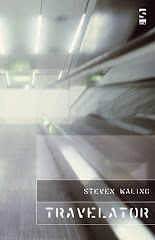So what does it mean to be 'non-mainstream' in this age? Having recently seen the extraoridinary Ursonate performed in a dank basement in Bury, a 'sound-poem' in sonata form (roughly) first performed in 1930's Germany, it's hard to think that there's any point in the term avant garde anymore. Ron Silliman, of course, has, along with others such as the late Reginald Sheppard, coined the term Post-Avant for what comes 'after the avant garde.'
Everything has been done before, at least in terms of shocking audiences and provoking the reaction, "but that's not poetry/art/music/etc..." in an audience used to the familiar shapes of poetry before modernism came along. These days, most readers don't expect poetry to always rhyme; nor do they always expect it to 'make sense' in the way it used to do, supposedly, in some mythical golden age of simple lyric poetry.
There are still people who get shocked by sound poetry and concrete poetry; but I suspect there's much less than there used to be of shocked responses. These days, people who like it like it, and those who don't get bored by it, except possibly in the fulminating backwaters of the odd Neo-Formalist magazine, still fighting battles that everyone else got exhausted by long ago.
There are still people around who remember the so-called Poetry Wars at the Poetry Society of the late '70's; and the fact is that a lot of really interesting writers went into the wilderness for a good few years, only emerging years later with egos and reputations still bruised. Most young writers, I suspect, look on it all with some bewilderment.
That 'experimental writing' still survives, and is being practised by young writers fresh out of university, is a sign of health for the whole of the writing community. But it's no good pretending that we're any kind of avant garde. Even the 'flarf' and 'conceptual' schools of poetry are only going places that somebody has been before: flarf is a form of collage and conceptual art has been around since the '60's.
What marks out the 'non-mainstream' from the 'mainstream' then? Well, to be honest, it's partly a tribal allegiance, isn't it? Going to The Other Room, I hear plenty of snide remarks about Duffy and Armitage, and I'm as guilty as many in making the same remarks about Andrew Motion. The fact that I don't at all find his poems interesting or engaging is not really his fault though. That he's more likely to be reviewed by the Guardian than, say, Robert Shepherd or Maggie O'Sullivan says something about the values of the mainstream; but it does get dull to be always harping on about it.
There are still, I think, two basic approaches to writing: one is the direct, denotative, logical, descriptive route which is largely the approach of the mainstream; the other is associative, fractured, disruptive, illogical, indirect route favoured by the non-mainstream. Both can produce great writing, and bad; and we all have out preferences for one over the other. Then again, the direct route is not always as direct as it seems, and the indirect isn't always as indirect as it seems: or, you tak the low road and I'll tak the high road, and I'll be in Scotland afore ye. But we're both getting to Scotland, as it were.
JESUS OF NAZARETH AND THE FRENCH TURN TO GOD
2 weeks ago

